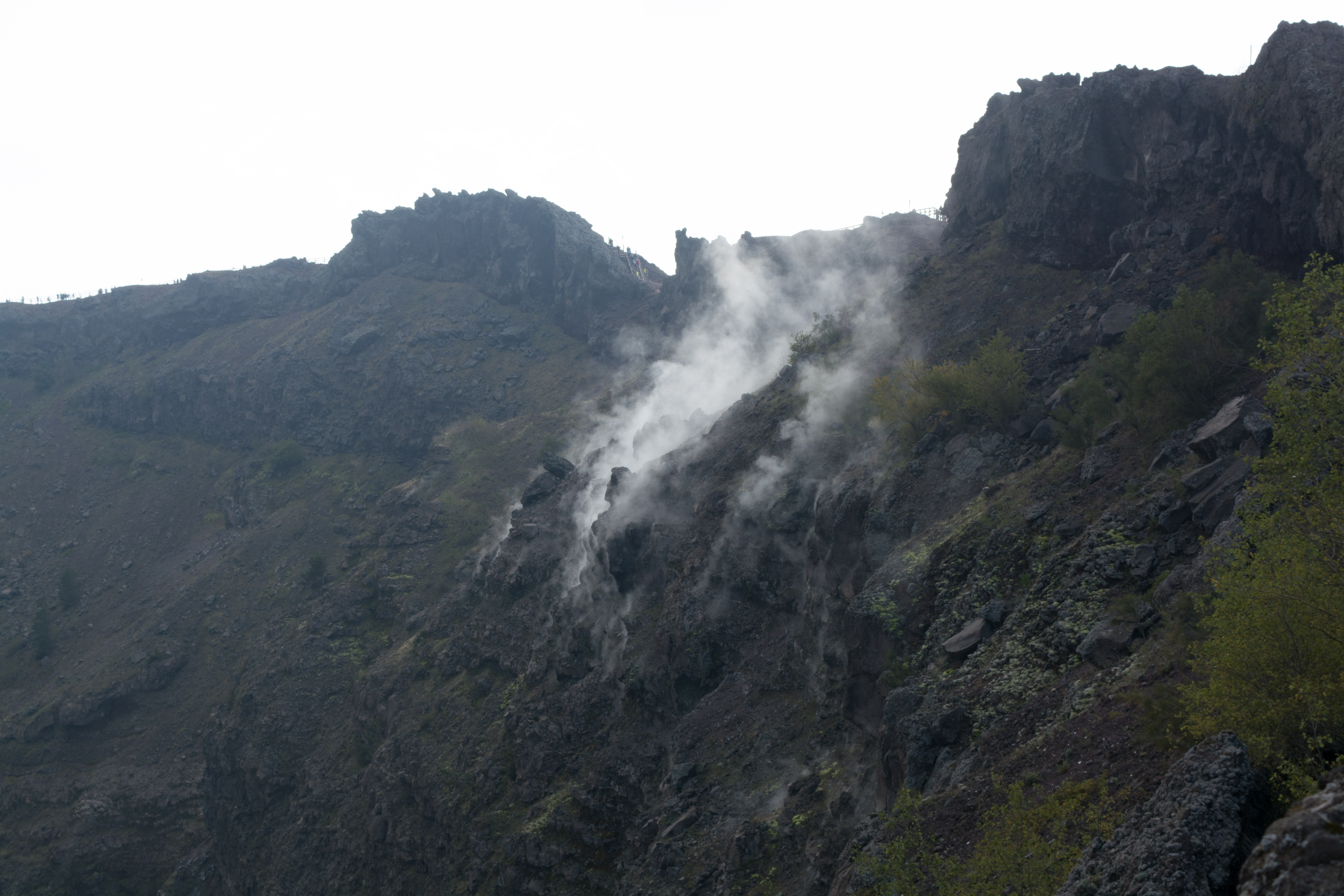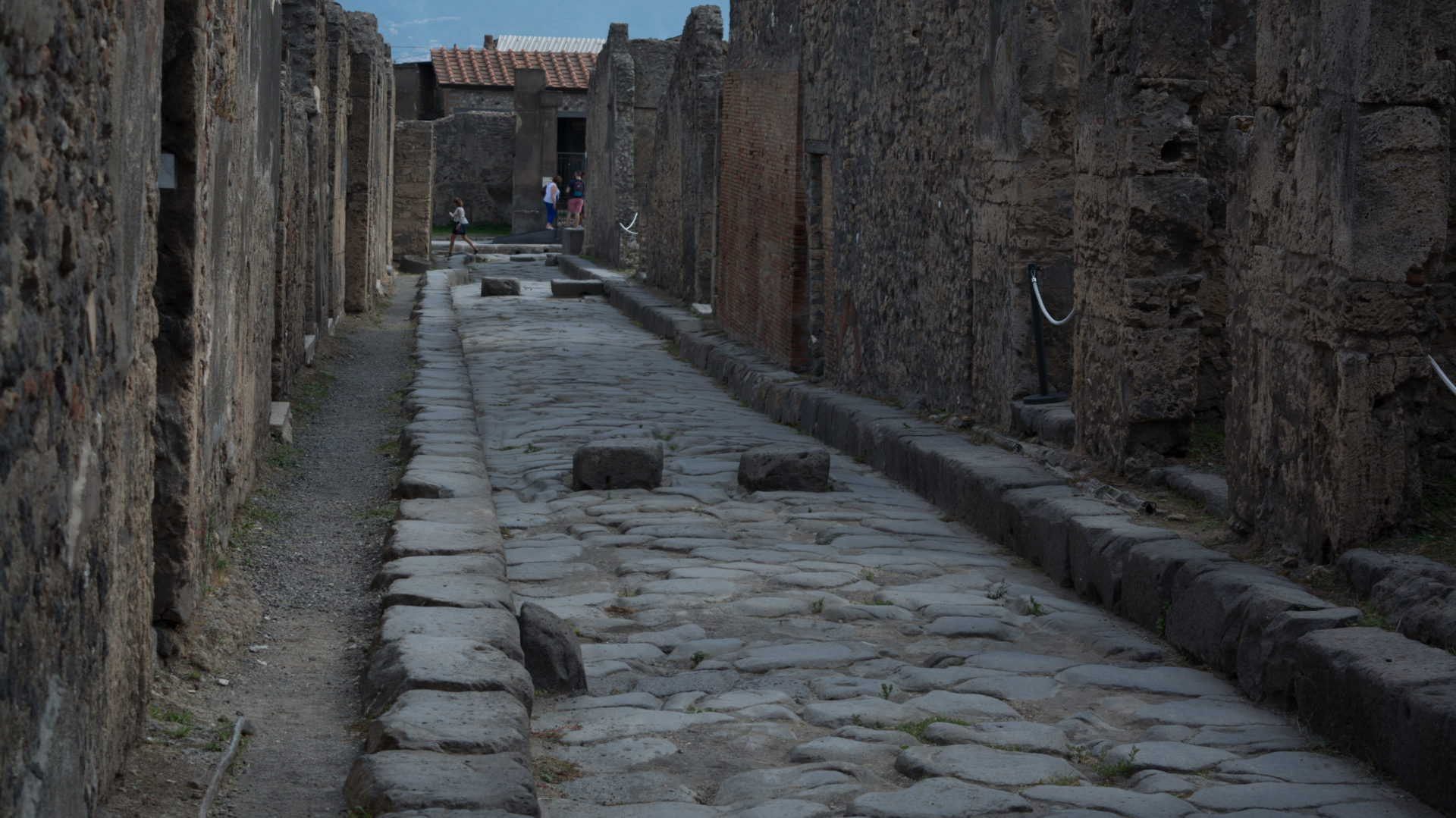We slept a little later on Day 7 than we had on the previous days. We did not meet at the bus until 9:00, but the extra time was valuable because we had quite a climb ahead of us. I took the time to eat a larger-than-usual breakfast, pack some extra water and snacks, and decide how much of my photography gear (or “kit” if you’re British) I was taking up the mountain. The night before Tony and Sirah had recommended that we dress in layers because it was warm at sea level but only 65 degrees at the top. They also recommended hiking boots (I had brought a pair along specifically for this climb) and a little cash for the souvenir shops that are scattered around the crater. Vesuvius rises 4,000 feet above sea level, which as far as I can recall makes it the highest mountain I have ever climbed.

At 9:00 we all boarded the bus and started a fairly short drive to the base of the mountain. Along the way Tony reminded us that, just as in Roman times, wine is still being grown on the slopes of Vesuvius. This wine is called Lacryma Christi, meaning “Tears of Christ.” There is a souvenir shop at the top of the mountain that will let you buy a small sample glass for 1.5 Euros. You can also buy bottles, but they are very expensive.
We did not start our climb at sea level. Instead we drove most of the way up the mountain until we were inside the crater of AD 79. Along the way we passed some lava flows from the last eruption, which occurred in 1944. These were in the process of being vegetated over, and someday soon these will be invisible beneath the brush:

The lava from the eruption of 1944 came out of the mountain through the same weak spot in the crater that led to the destruction of Herculaneum. On the way down it destroyed the road leading to the top of the mountain, so parts of the road we drove on were built on top of the lava from 1944. In a few places we could see parts of the old road peeking out from under the rock.
Once we reached the car park at the end of the road we all disembarked and headed for the hiking trail. Near the trailhead is a gentleman who makes wooden walking sticks. He hands them out to passersby and asks only that you give him a 1 Euro coin when you bring it back down. I was happy to take one of the hiking sticks along. At this altitude the air is thinner and catching your breath is noticeably harder, so every little bit helps. But even without climbing the views up here are already breathtaking:

The wall of rock you see in the distance is the edge of the crater of AD 79.
The hiking trail consists of several switchbacks leading up to the summit, and by the time we got to the first hairpin turn we could see the town below:

I took a slower pace on this hike than I normally would back home. There is less oxygen up here, and I did not want to risk developing altitude sickness (which has happened to me before). But once I reached the summit the views were definitely worth the climb! Inside the crater we could see volcanic steam rising from the rock:

The modern city and the Bay of Naples stretched out below, partially hidden beneath the fog:

Here is a view down into the bottom of the modern crater:

On my way to the gift shops I passed a spot where people have left portraits of the Blessed Virgin Mary, some rosaries, and some coins. One of Mary’s many titles is, “The Blessed Virgin of Pompeii,” so reverence to Mary is quite common here:


Making my way around the crater, I grabbed this shot to help put it all in scale. The people hiking in the top left corner make it easy to understand how massive the crater is, and how much steam was being emitted on the day we were there:

There are three souvenir shops scattered around the crater, and at the farthest one you can buy a small sample of Lacryma Christi. There are several other beverages available for sale, as well as sandwiches:

Bottles of Lacryma Christi grace a nearby wine rack:

And at the rear of the shop are some small statues carved from lava:

While I was here I bought a few postcards, a Rosary made from lava rocks, and (of course) a sample glass of Lacryma Christi. To be honest, it was not my favorite wine. But I did enjoy being able to sip it while looking out from the summit at the city below.
As we started the climb back down I asked our photographer, Dot, to take a portrait of me with the volcanic steam rising in the background. Here I am looking very tired, but feeling thrilled to have made it all the way up here!

After stopping for lunch at a restaurant about halfway down the mountain we spent our afternoon visiting the Villa at Oplontis. This was certainly the most luxurious house we visited over the course of the tour, and as beautiful as some of the pictures are it was even more impressive in person!
The villa is a large U-shaped building, only half of which has been excavated. The other half remains buried beneath a road and several occupied buildings, so like Herculaneum it is unlikely that we will get to see the whole thing any time soon.
We entered the villa from above via a long staircase:

Terracotta figures are still present on the roof tiles:

As we moved from room to room we saw some of the most incredible frescoes of the entire tour:




And a large open courtyard:

The villa has a large rectangular pool at the rear:

And on the other side of the pool are even more frescoes:


There is also a plaster cast of a window shutter, still hanging in a partially open position:

Outside of the villa the excavations have left the strata clearly visible. Tony pointed out the layer from the eruption of AD 79, which was very thick and composed entirely of ash and pumice. We were able to pull out a few pumice stones to examine. Pumice is very light and will even float on water (for a short time). I found a little hollow in the wall and took a photo inside of it to give you a good close-up look at this layer:

After finishing our time at the villa we got back on the bus for the short drive back to the hotel. This would be our last night there, in the morning we would be visiting our final site before heading to the airport for our flights home.
That was all for Day 7! Check back soon for Day 8, our final day of the tour, when we visited the Benedictine Abbey near the hotel.
